Residents of Ortley Beach, quickly dubbed “ground zero” for Superstorm Sandy, marked the tenth anniversary of the storm by sharing memories and paying it forward over the weekend.
A group of residents gathered at St Elisabeth’s Chapel, a small Episcopal church on Third Avenue, steps from the ocean, which was destroyed in the storm. Its congregation rebuilt after the storm, itself characterizing the resilience of the community as a whole. It was no coincidence that residents were drawn there a decade later.
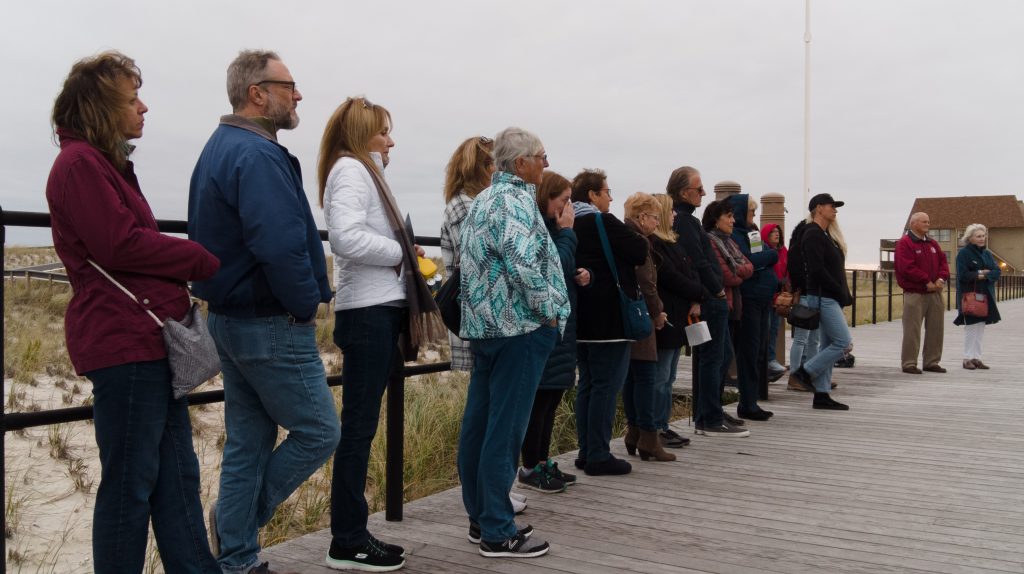
Ortley Beach residents and officials gather to mark the 10th anniversary of Superstorm Sandy, Oct. 29, 2022. (Photo: Daniel Nee)
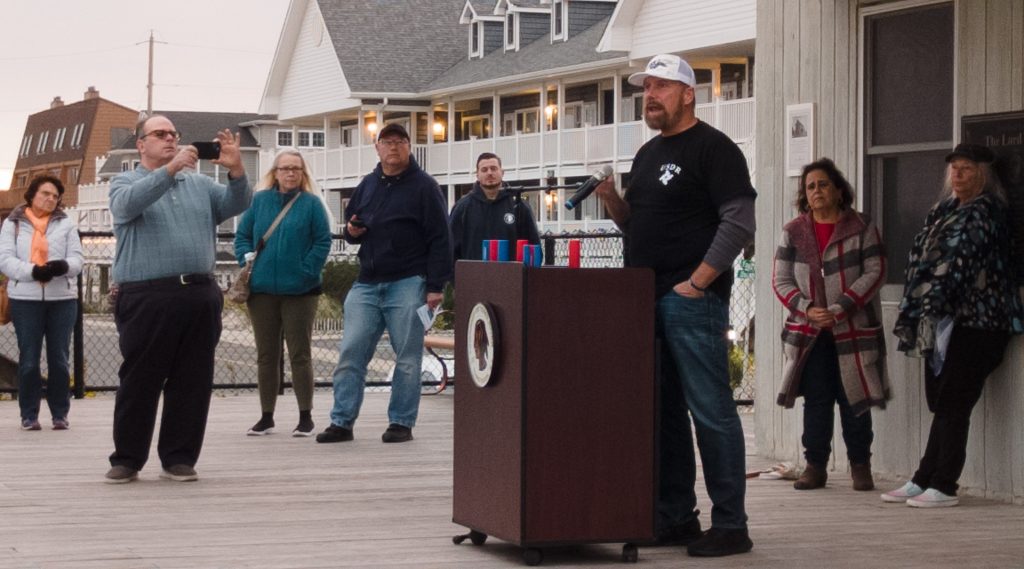
Ortley Beach residents and officials gather to mark the 10th anniversary of Superstorm Sandy, Oct. 29, 2022. (Photo: Daniel Nee)
The residents, many members of the Ortley Beach Voters and Taxpayers Association which became a vital force in the rebuilding effort, shared stories of the miserable experience of finding one’s home destroyed, the humbling experience of being helped by strangers and the empowering experience of helping neighbors in need. They were joined by officials including Toms River Mayor Maurice “Mo” Hill – at the time of the storm, a councilman – and Ocean County Sheriff Michael Mastronardy – at the time of the storm, Toms River’s police chief.
The entire group, which also included volunteer leaders and residents who were faced with the loss of their homes, proceeded to the boardwalk after a prayer service at St. Elisabeth’s, where they marched to the Lord House lifeguard station and shared memories before holding a candlelight vigil. The vigil served a dual purpose – powerful flashlights were used instead of candles, and all would be donated to volunteers helping the Ft. Meyers, Fla. rebuilding effort in the wake of Hurricane Ian last month.
“From the day of the storm through the first several months, we relied on the volunteer groups, the EMS department, the fire department, the police department and Public Works … to provide a good starting point for us to rebuild the Ortley Beach that we see today,” said neighborhood resident Anthony Collucci.
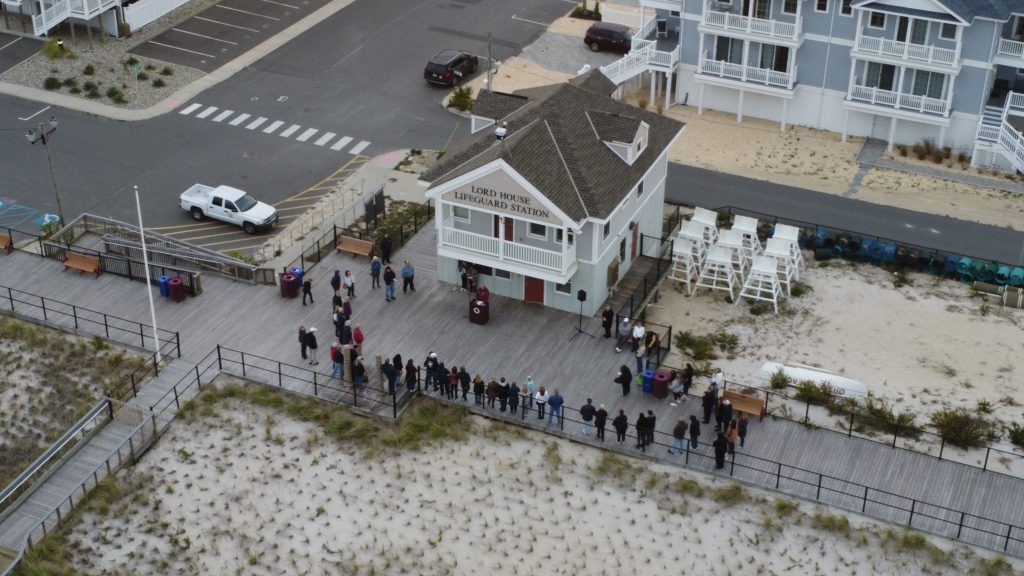
Ortley Beach residents and officials gather to mark the 10th anniversary of Superstorm Sandy, Oct. 29, 2022. (Photo: Daniel Nee)
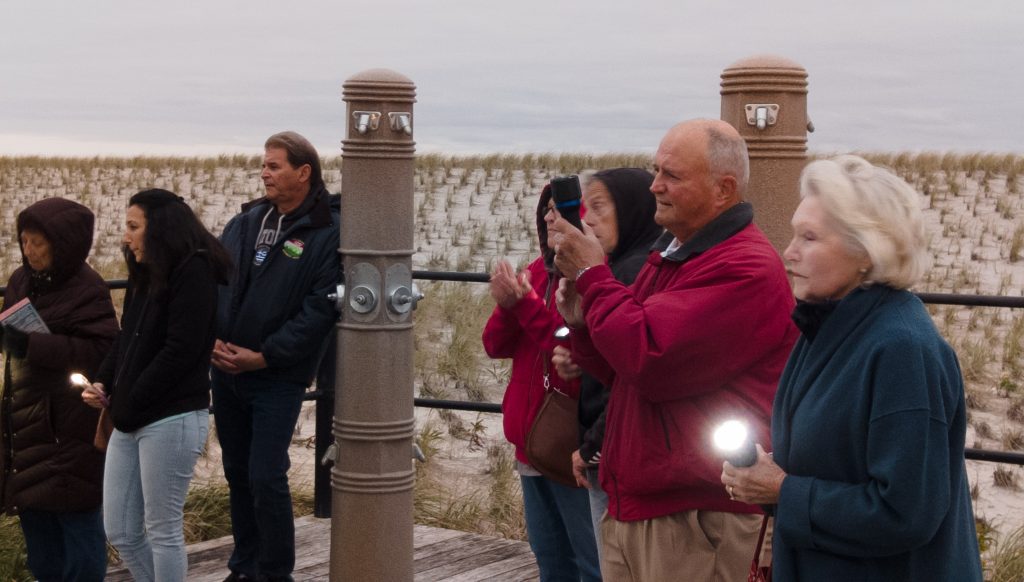
Ortley Beach residents and officials gather to mark the 10th anniversary of Superstorm Sandy, Oct. 29, 2022. (Photo: Daniel Nee)
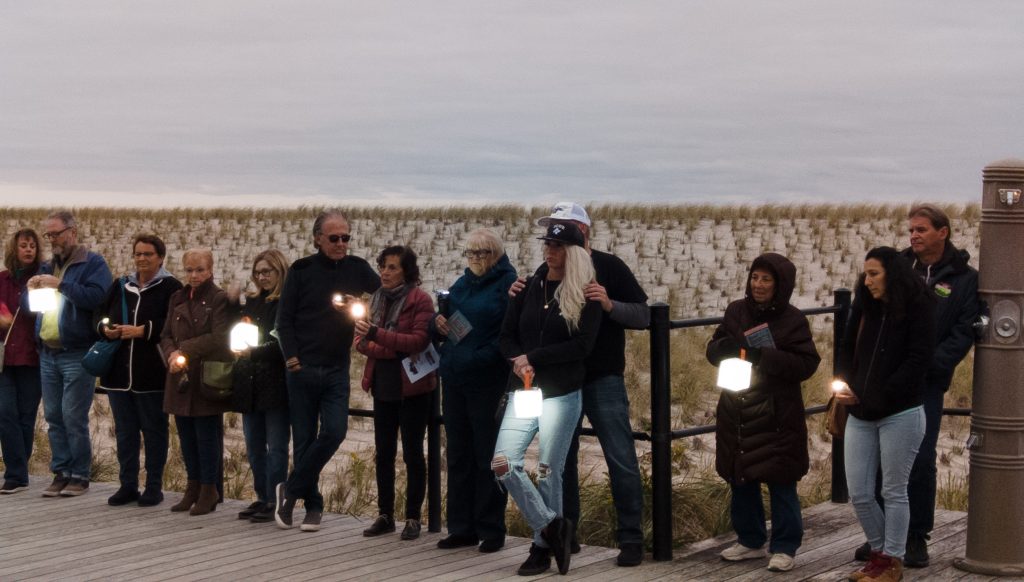
Ortley Beach residents and officials gather to mark the 10th anniversary of Superstorm Sandy, Oct. 29, 2022. (Photo: Daniel Nee)
In Toms River as a whole, about 13,000 properties received damage, 8,000 were flooded and 4,000 were substantially damaged. Most of the memories consisted not of seeing breached dunes, an inlet forming across Route 35 at the Mantoloking Bridge, cars hanging out of the second-story windows of homes or the Surf Club breaking apart in the waves – but the simple acts of kindness between neighbors.
“My mother had a property on Green Island and I remember all of us going out, cleaning furniture out of everybody’s houses and Public Coming to pick up the debris,” said Hill.
Collucci recalled a group of Mormon missionaries showing up at his home as he and his wife stood in shock and wondered where to start cleaning out their house.
“The women comforted Sharon as she packed up the China and silverware,” Collucci said, choking back tears.
Mastronardy was tasked with some of the most difficult operations both during the storm and throughout the community’s recovery. Always known for being a hands-on leader, he hearkened back to his days as a patrolman – one of his first assignments after becoming a police officer was patrolling Ortley Beach – and tried to keep people safe and informed. At one point, coincidentally while on Third Avenue, he remembered a call he had received from a woman wondering if she might be able to return home in time for Thanksgiving.
“When I pulled up, the house was totally gone,” said Mastronardy. “I could look up my tax map on the computer in the car, and I said, ‘I”m sorry, I hate to do this over the phone, but your house is no longer here.’”
After getting out of the car to see if he could find any important items, Mastronardy tripped on a piece of debris and fell down. His hand was cut by a menorah buried in the sand.
“I got back to the car, and I told her the only thing left was a menorah, and she said, ‘that was my grandmother’s,'” he recalled. “A month later she came to headquarters and she broke down while picking it up.”
“As I come here, you get choked up with those memories,” he said.
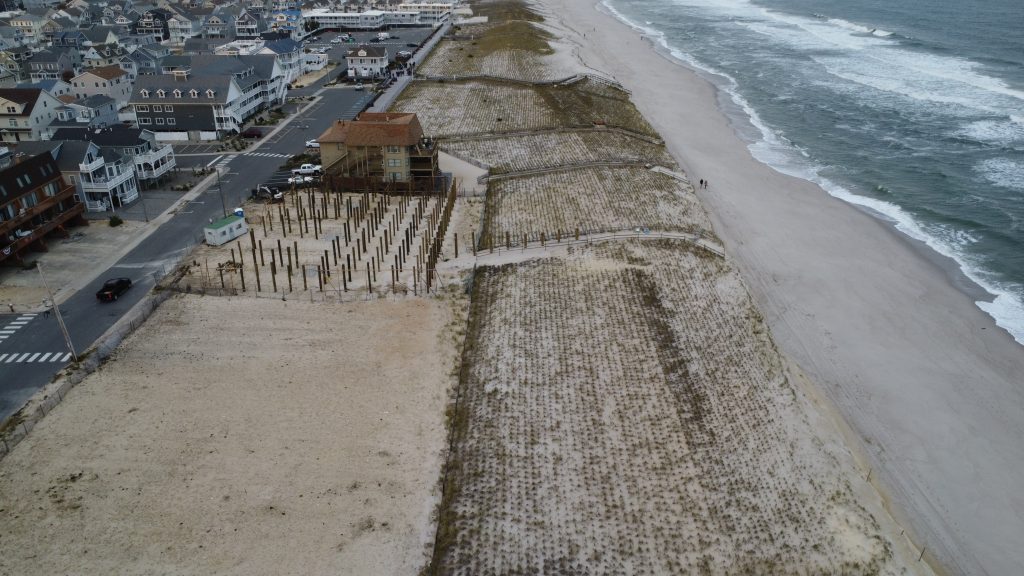
Ortley Beach residents and officials gather to mark the 10th anniversary of Superstorm Sandy, Oct. 29, 2022. (Photo: Daniel Nee)
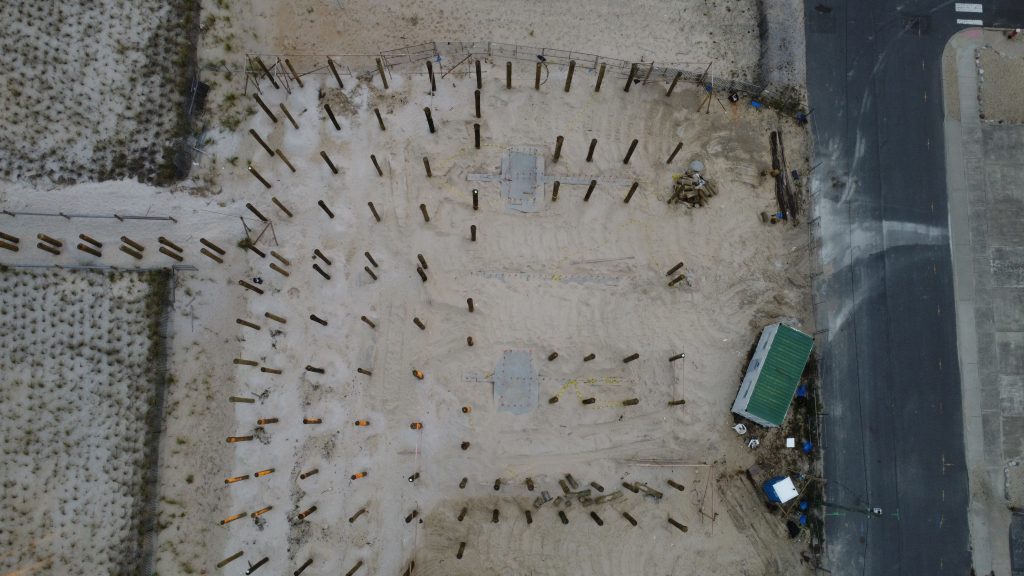
Ortley Beach residents and officials gather to mark the 10th anniversary of Superstorm Sandy, Oct. 29, 2022. (Photo: Daniel Nee)

Ortley Beach residents and officials gather to mark the 10th anniversary of Superstorm Sandy, Oct. 29, 2022. (Photo: Daniel Nee)
Most of the residents assembled also honored the memory of Cassandra Vitale, a local resident who had moved to Florida, but returned to New Jersey after the storm to start the Bucket Brigade, which grew to become one of the most helpful groups in the wake of the storm, with its volunteers taking on the exhausting task of assisting residents physically clean out their homes. Vitale eventually moved back home to Florida and died after a struggle with heroin addiction. Her family, in the aftermath, publicly talked about Cassandra’s battle in the hope of dissuading others from drug use.
Paul Jeffrey, a longtime leader of the Ortley Beach Voters and Taxpayers Association, still hangs onto one of the colorful, light-green bags that Vitale gave out with supplies to everyone whose home she helped restore.
“My grandchildren take it to the beach every time, and I like to be reminded of how much we helped each other,” he said, holding up the bag.
Hill said the neighborhood – and the township as a whole – is much stronger than it was a decade ago in terms of storm mitigation. Though there are often discussions about the width of the beach, the protective dune built by the U.S. Army Corps of Engineers has remained fully intact, seen the growth of dune grass and, most importantly, has never come close to being breached since it was built. The mayor said New Jersey should invest more in the protection of its coastal communities.
“That dune project, it’s doing its job. It’s protecting the property – and the people – on the island,” Hill said. “If we were to have another storm, I think that would be our best defense. Everybody from New Jersey enjoys our beaches, and I think that should be covered by the state.”
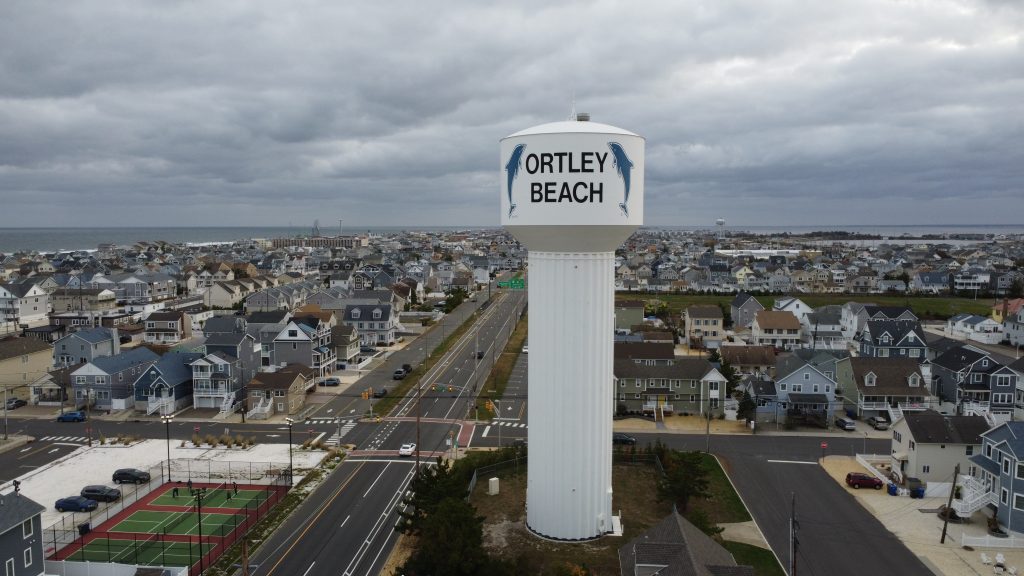
Ortley Beach residents and officials gather to mark the 10th anniversary of Superstorm Sandy, Oct. 29, 2022. (Photo: Daniel Nee)
Maria Maruca, a former councilwoman who served the barrier island ward, attended and echoed the feelings of dozens of others.
“One person said it was the worst time of my life and the best time of my life – the worst because we lost so much, and the best because the best of humanity came together to help.”
The residents gathered back at St. Elisabeth’s after the ceremony to host a virtual fundraiser for the Ft. Meyers area.

Advertisement

Ortley Beach & North Beaches
Landmark Ortley Beach Breakfast Spot Looks to Expand

Ortley Beach & North Beaches
‘Temporary’ 70-Foot Cell Tower on Route 35 in Ocean Beach OK’d to Return

Seaside Heights & Seaside Park
Beloved South Seaside Park Restaurant Will Remain Open As Developer Seeks to Demolish Block

Seaside Heights & Seaside Park
In Seaside Heights, A $50M Flagship Building Rises Over the Boulevard in a Famed Location

Police, Fire & Courts
Ocean County Sheriff Establishes Drone Command Center in Seaside Heights Amid New Video





